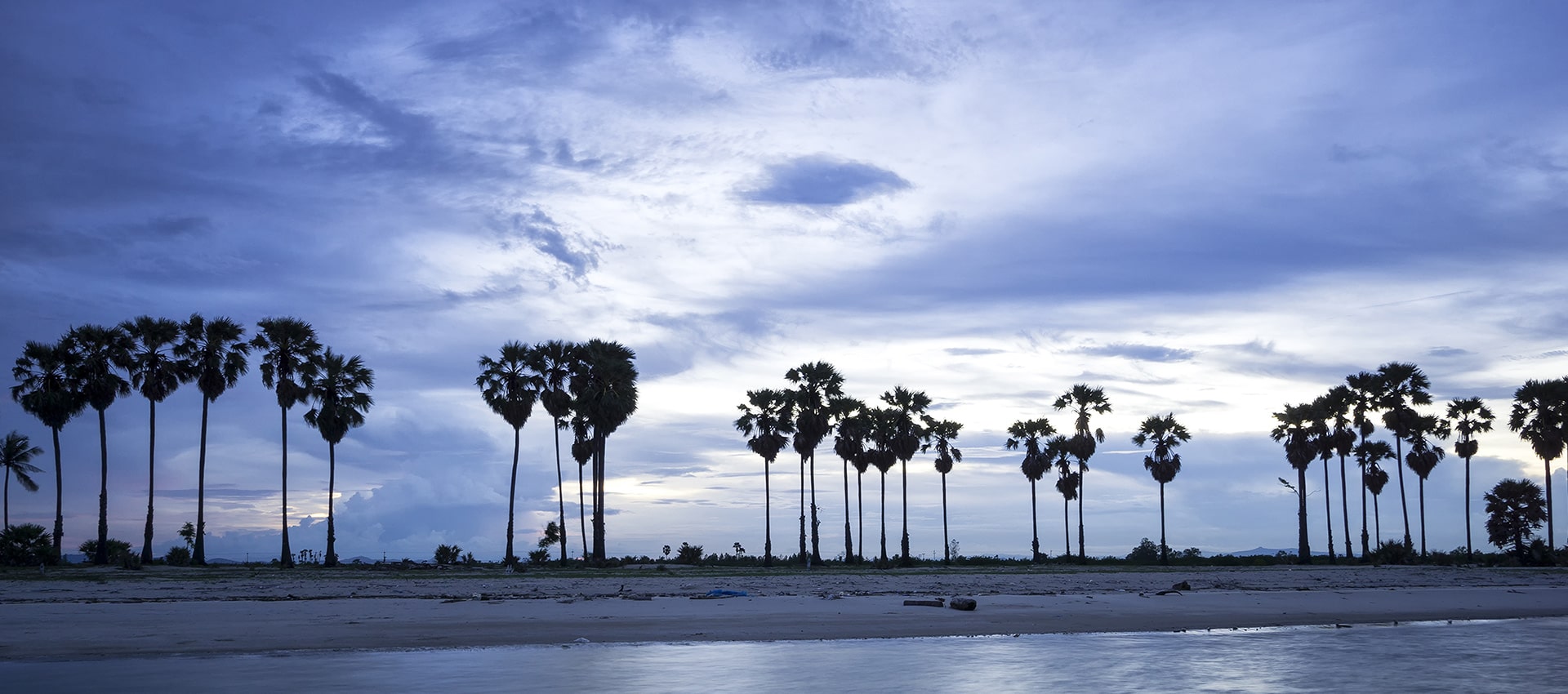Snapshot
Situated at the northern tip of Sri Lanka, the Jaffna peninsula is steeped in history. Explore Jaffna town and surrounding areas, or visit one of seven inhabited remote islands. The landscape is dotted with Palmyrah Palms and lagoons where flamingos flock after the rains. Jaffna underwent much hardship due to terrorism and, ultimately, a full-scale war between the LTTE and the Sri Lankan armed forces which ended a 26-year conflict. The trauma lingers, but since 2009, the people of Jaffna are rebuilding their lives with renewed hope. An enriching experience for the adventurous traveller.
Weather
The temperature in the north of Sri Lanka is at its highest during April/May and August/September. The North East monsoon rains are between October to January. Best time to visit is in birding season from September to March when the lagoons are filled with water, the paddy fields and vegetation are lush green, the air is cooler and the migrant birds including flamingos, ducks and other waterbirds line the lagoons in their thousands.
Getting There
From Colombo, the fastest route is along the North West coast to Anuradhapura (the midway point) and then on the A9 to Jaffna which will take about eight hours. Direct flights from Colombo airport are also available. We recommend travelling to Jaffna by express train which runs daily from Colombo. Relax in a comfortable, air-conditioned compartment and enjoy the varied scenery and glimpses of local culture as you travel. The journey takes around six hours.
Once in Jaffna town, the roads are well signposted and routes to the North and West are in good condition for the most part. Getting about is best done in a pre-arranged vehicle. Public transport is limited. The islands of Kayts, Punkudutivu and Karainagar can be accessed by causeway, Delft and Nainativu by boat or ferry.
Highlights
- Visit Colonial period churches in Jaffna town
- Eat fiery Jaffna crab curry or Thosai with Rasam on a banana leaf
- Shop in bustling Jaffna market
- Watch graceful wild horses on Delft island
- Take a dip in the sea at Casuarina beach in Karainagar
- Flocks of pink flamingos in Mannar during the birding season
Jaffna town:
Jaffna town, with its maze of narrow roadways, is easy to get about with a good map in hand. The ancient Nalllur Kandasamy kovil, St. Mary’s Cathedral, Jaffna Fort and Jaffna’s Archeological Museum are some of the more interesting sites. Drop by Jaffna market for souvenirs and handicrafts.
Nallur Kandasamy Kovil:
Many larger Hindu kovils hold pageants from July to December. During these colourful festivals, the temple deity is paraded in an elaborate chariot. The festival conducted by the Nallur Kandasamy Kovil goes on for 26 days in August. Devotees in their thousands from all over Sri Lanka attend this festival. The Buddhist sites come alive especially during Vesak on full-moon day in May in veneration of the life of Lord Buddha and in June (Poson) when the introduction of Buddhism 2,500 years ago is commemorated.
Point Pedro:
Head North on the Kankesanturai (KKS) road to Point Pedro with its lighthouse staring out to the Bay of Bengal. The ancient Naguleswaram Shiva kovil, Keerimalai hot springs and ruins of the Kanthrodai Buddhist temple are all. The more adventurous head North East – a remote area where the sand dunes of Manalkadu are scattered with Casuarina trees. The ruins of the Portuguese-period St Anthony’s church and burial grounds rise up from the sands creating a unique landscape.
Karainaragar causeway:
West of Jaffna town can be accessed via the Karainaragar causeway. Birding on the lagoons during the migrant season from September to March can be utterly rewarding
Vaddukoddai Portuguese church:
Spend a morning’s excursion exploring the Vaddukoddai Portuguese church; Punnalai Varatharaje Perumal Kovil, and the sandy beaches of Casuarina north of Karainagar. Stop by for lunch at Fort Hammenhiel – a Portuguese-period fort built in the sea
Delft Island:
The Jaffna islands are also fascinating. Spend a day out at Delft Island with its small village homes, wild horses that roam the plains, and ruins of a Portuguese Fort. Nainativu Island is easier to access and is home to the ancient Nagadeepa Buddhist temple and the Naga Pooshani Ambal Hindu temple
Mannar:
Bird watching is rewarding in Mannar during the migrant season from October to March when flamingos and numerous other birds line the lagoons and waterways.
Mannar Fort:
Mannar Fort was built by the Portuguese in1560 before falling to the Dutch a century later and being rebuilt, and later occupied by the British. The ruins lie next to the new bridge that connects the mainland with Mannar Island. The fort can be visited and is occupied by Sri Lanka Railway.
Nagadipa was supposedly the ancient name given to the Jaffna peninsula. Nagadipa is first mentioned in the Pali chronicles of Sri Lanka in connection with the story of the Buddha’s second visit to the island in the 6th century BC when he made peace between two Naga kings who were about to wage war over a gem-set throne.
Jaffna had been one of the four main seaports in Sri Lanka since ancient times. In addition, its proximity to India over the Palk Straits, with a width of only 30kms, resulted in frequent invasion by the powerful Dravidian kingdoms in southern India. One of the best-known incidents was the victory in the 2nd century BC of the Sinhalese king Dutugemunu over the Tamil usurper Elara.
From the 12th century, the Tamils made increasing inroads into the northern part of Sri Lanka, and by the early 14th century, they were sufficiently strong to establish a kingdom centred on the Jaffna Peninsula.
The Portuguese conquered Jaffna in 1619. The horseback statue of Jaffna's King Sangli still stands in the city. They systematically demolished Jaffna's Hindu temples and a wave of mass Christian conversions and building of churches took place. Many Hindu temples were not rebuilt until the mid19th century.
Jaffna surrendered to the Dutch after a bitter three-month siege in 1658. Various Portuguese and Dutch fortifications remain dotted around the peninsula, but most are either ruined or still in military use. During the Dutch era, Jaffna was populated by south Indians brought into the peninsula for the cultivation of tobacco. In 1795 the British took over Jaffna, sowing the seeds of future inter-ethnic unrest by allegedly favouring the Jaffna Tamils because of a perceived stronger work ethic.
A 26-year civil war in Sri Lanka blighted the island between 1983 and 2009 as the LTTE (Tamil Tigers) fought to create an independent Tamil state called Tamil Eelam in the north and east of Sri Lanka.
Fox Resorts
Great traditional rice and curry at a good price (257 K. K. S. Road, Jaffna, 0217 400 400)
Amachi Restaurant
Serving delicious authentic vegetarian dishes, Amachi has an all-female staff to support female empowerment in Sri Lanka (Palali Road, Jaffna 40000)
The Peninsula
Jetwing Jaffna’s pleasant bar and restaurant, serving international cuisine in a great atmosphere (37 Mahatma Gandhi Road, Jaffna 40000, 0212 215 571)
Rio Ice Cream
Uncontestably the best ice cream in Sri Lanka (448A Point Pedro Road, Jaffna 40000, 0212 227 224)
Popular Activities

Visit to Point Pedro
Jaffna, Sri Lanka
Point Pedro, also known as Sakkotai Cape, is the northernmost tip of Sri Lanka. An unpretentious spot replete with significance, it was once a trading port.
Duration: 2 hours
Best time: Year-round
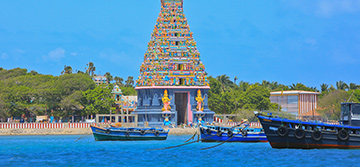
Visit to Nainativu Island by Boat
Jaffna, Sri Lanka
Take a 30-minute boat ride to Nainativu, one of the smallest inhabited islands in the Gulf of Mannar. The name of the island alludes to the folklore inhabitants, the Naga people, considered one of the first tribes in Sri Lanka.
Duration: 2 hours
Best time: Year-round
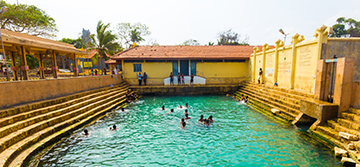
Visit to Hot Springs in Keerimalai
Jaffna, Sri Lanka
Located in Jaffna, the Keerimalai hot springs is a renowned mineral water spring that is shrouded in folklore, believed to have healing properties. Separate entrances for women and men.
Duration: 3 hours
Best time: Year-round
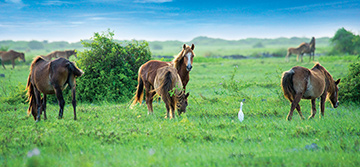
Jaffna Islands
Jaffna, Sri Lanka
The Jaffna islands are fascinating to explore. Spend a day out at Delft Island with its small village homes, wild horses that roam the plains, and ruins of a Portuguese Fort.
Duration: 3 hours
Best time: Year-round
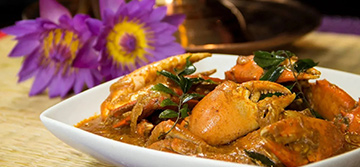
Jaffna Crab Curry Cooking Class
Jaffna, Sri Lanka
Learn how to clean fresh sea crabs and how to prepare traditional Jaffna crab curry, a dish renowned throughout the island, before sitting down to one of the best meals you will have in Sri Lanka.
Duration: 2 hours
Best time: Year-round
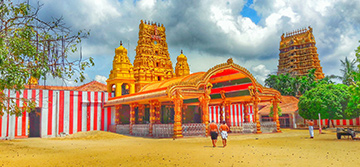
Nallur Kandaswamy Kovil
Nallur Kandaswamy Kovil நல்லூர் கந்தசுவாமி கோவில், Jaffna, Sri Lanka
One of Sri Lanka’s most prominent Hindu temples, Nallur Kandaswamy Kovil was originally built over 1,000 years ago. It boasts many beautiful pieces of colourful and dramatic architectue.
Duration: 2 hours
Best time: Year-round
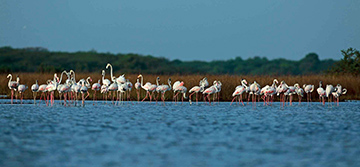
Chundikulam National Park
Chundikulam National Park, Sri Lanka
Chundikulam National Park is slowly regaining recognition as a birders’ paradise as the Jaffna peninsular gradually begins to attract travellers once again.
Duration: 3 hours
Best time: March to September
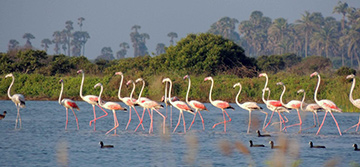
Birdwatching in Jaffna
Jaffna, Sri Lanka
Bird watching in Jaffna during the migrant season from September – March is a highlight for nature lovers. Migrant birds along with other waders in their thousands flock to the lagoons.
Duration: 2 hours
Best time: September to March
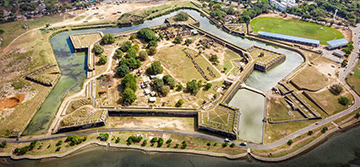
Jaffna Dutch Fort
Jaffna Dutch Fort, Jaffna, Sri Lanka
It was the Dutch who expanded Jaffna Fort in 1680 and, more than three centuries later, they are financially supporting its renovation.
Duration: 3 hours
Best time: Year-round
